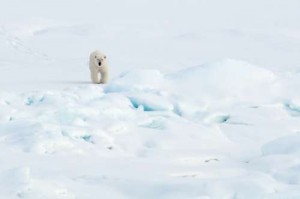A new study released Tuesday by the U.S. Geological Survey suggests polar bears are in the midst of a generations-long migration to areas that still have year-round sea ice.
Lily Peacock is a research wildlife biologist for USGS and the lead author of the study. She says, historically, polar bears are highly nomadic and move unpredictably. But, over the last few generations, the bears’ movement patterns have been changing.
“Instead of sort of random movements of bears across the Arctic that we found in sort of the more ancient historical picture, we found directional movement towards the Canadian Archipelago,” Peacock said.

The Canadian Archipelago is home to one of four clusters of genetically-similar polar bear populations. During the study, Peacock’s team analyzed nearly 3,000 genetic samples of bears ranging from Alaska’s North Slope, to the Russian Arctic, to Canada’s Hudson Bay, dating back as far as 1972, and as recently as 2011.
Peacock says this suggests polar bears are subtly shifting north.
“Our hypothesis is that they’re doing so because changes of in their habitat,” she said. “Especially because it’s been hypothesized and modeled that that’s where ice is going to be persistent and it’s likely that the ice might become better habitat in the Canadian Archipelago; it’s considered poorer habitat right now, but the multi-year ice might become annual ice and become more productive.”
Peacock says this shift isn’t a product of bears marching en masse from Northern Russia all the way to Northern Canada – it’s more of a genetic migration, made over the course of several generations.
“That means an individual home range shifting northward; that animal mating with another animal that might be at the southern part of her range, but then that offspring might go to the northern part of her grandmother’s range and mate with someone else,” Peacock said. “So it’s sort of this shift of genes northward.”
But, according to Peacock, declining sea ice could put a damper on the process and potentially threaten worldwide populations by cutting off the bears’ migration routes.
“And what can happen when populations of animals become isolated is that they can blink out if something happens; if they have a bad winter or bad spring and that stresses the population and it gets smaller and smaller, but the migration corridor has been cut off and you can’t repopulate,” she said.
Though scientific modeling can’t predict exactly what the future holds for polar bears, Peacock says the results of the study say the Canadian Archipelago may become a very important habitat for polar bears over the next several generations.
Josh is the Statewide Morning News Reporter/Producer for Alaska Public Media | jedge (at) alaskapublic (dot) org | 907.550.8455 | About Josh




